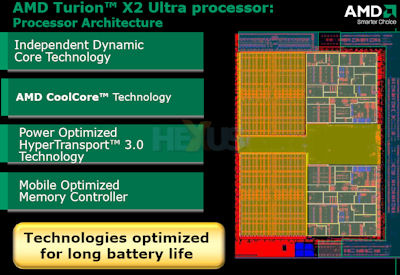It's not all about the CPU, but...
Puma in detailWe've made mention that Puma features what, at first glance, appears to be a re-badged Turion 64 X2 CPU and mobile 780G chipset. We'll now explain their features in more detail, comparing it with incumbent solutions, and evaluating whether AMD has a potential hit on its hands.
Overview
Looking from top to bottom, the Puma platform is driven by the Turion X2 Ultra CPU, code-named Griffin. Note that AMD has dropped the '64' nomenclature from the product name, but the processor still supports 64-bit registers.
The CPU
As we alluded to in our piece last year, Griffin is practically performance-identical to the 65nm-based, dual-core Turion 64 X2 of the Kite Refresh platfom. Based on the Athlon 64 X2 desktop chip, DDR2-800-supporting Turion Ultra beats out the incumbent processor by having a newer, faster HyperTransport 3.0 link, meaning quicker transfers from processor to the chipset, which is beneficial when running memory-starved integrated graphics. High-end Turion X2 Ultras will ship with 2MiB of L2 cache - 1MiB per core - doubling what's currently available. AMD, though, wouldn't divulge clockspeeds, stating that it reckons the CPUs are 'good enough' for a mobile environment.
Secondly, the newer CPU has a greater number of frequency/power-states, now totalling eight, and offering better granularity (and power-saving, therefore) in mobile mode. The switching between states has been improved, too, and is digital, rather than undertaken solely by the traditional PLL (phase-locked loop).
Thinking more about power, Turion X2 Ultra features three independent power planes, two for the processor's cores and one for the northbridge. This arrangement allows each core and northbridge to be frequency- and voltage-scaled to best-fit the application that's currently being run. For example, running a single-threaded application, where no real benefit is derived from pushing the second core at full bore, would mean that the unused core be scaled down, both in terms of freqeuncy and voltage, to better-preserve battery life.
The up-to 35W Turion X2 Ultra will ship in the same S1 package as the current Turion 64 X2, but won't be drop-in upgrade. Rather, AMD is effectively bundling it with the M780G chipset, which we'll talk about in a moment.
We initially questioned the conspicuous absence of a newer, more-powerful CPU, especially when Intel has consistently upped the ante with its mobile processors, but, really, we reckon that AMD has got it just about right, balancing the battery longevity against pure performance. After all, processors are fast enough for everyday tasks conducted by most users.
We'd like to see a move to power-saving 45nm manufacturing process as soon as possible; it would make the CPUs both cheaper to produce and more energy-efficient, which appears to be one of the watchwords for Puma.











